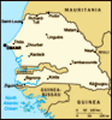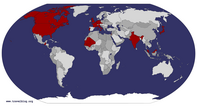Advertisement
Published: October 21st 2007
It's been a couple weeks since I've updated, but life isn't all fun and games here in Dakar. We do actually go to classes occasionally, and we sometimes have homework, too!
Last weekend (Saturday, to be exact), the majority of Senegal celebrated Korité. In most part of the world, this holiday is called "Eid el-Fitr" but here, the end of Ramadan is known by the Wolof word instead. Everyone kept telling us that it was going to be a huge party, a great time, etc. etc. I suppose we shouldn't have gotten our hopes up after having lived through the "great cultural experience" that is Ramadan (it was so boring!).
Korité is a "huge party" in the sense that New Year's Day is a rocking holiday. You wake up early because there is quite a bit of noise in the house, you sit around all day because nothing is open, you wait for a delicious dinner that is promised to be served at 2pm (when really, we all know it won't be ready until at least 4pm), and then after eating, you sit around and wait until you can eat leftovers. The food was delicious though - we had
chicken (it really does exist here in Senegal!), fries, cucumbers, tomatoes, and green peppers. It's all served on one giant platter, and you smother it with mustard and a sort of coleslaw and eat it with your hands and a hunk of bread. It was so delicious, and we ate another huge meal of leftovers for dinner.
Neighbors dropped by throughout the day, and everyone was very well-dressed in their boubous (traditional outfits). At one point, I was in my room reading, and eight kids (who I have never seen before) pile into my little room. After greeting all of them and shaking hands, they just stood there and stared at me. It turns out that adults are expected to give children money on Korité. I guess I counted as an adult in this situation because they wanted some coins, but I didn't have nearly enough to give out to everyone, and I certainly wasn't going to start handing out 5000cfa bills (about $10) to everyone. I kept protesting "amuma xaalis!" (I don't have money!), but they just stared expectantly. I found some packs of gum, and they grabbed them out of my hand and ran out of the
house without even so much as a "jerejef" (thank you). While this continues to strike me as incredibly rude, it's just the norm here...please and thank you are often forgotten.
Anyway, enough about my being let down by one of the biggest holidays of the year. On to....CAMELS!
We decided that we needed to get out of Dakar and out into the desert. The desert in Lompoul is a weird little quirk of Senegalese geography. It's like a little chunk of the Sahara got misplaced in Western Senegal. We decided that this was a chance we couldn't pass up, so we bought provisions for lunch, negotiated a sept-place fare, and piled into a station wagon for the three hour journey to Lompoul. Our driver dropped us off in the village of Lompoul, where we really had no idea how to get ahold of the campement to get a 4x4 vehicle to drive us the last few kilometres to the camp site. As it usually is in Africa, things just sort of worked out. A guy, not too much older than us, got on his cell phone (we had perfect reception out in the desert!) and arranged things with
a truck.
While we waited in the village, we were swarmed by practically all the village inhabitants. The children demanded that we take photos of them, and the women came over with string of beads on their arms. One came over to me, asked me my name, and proceeded to lift up my arms and pull a string of beads over my head, down over my breasts, where they settled around my waist. I opened my mouth to protest, but she ignored me. Instead, she pulled up my shirt, showed the entire village my stomach now decorated with brown and yellow waist beads. She made a comment about my jaay foonde, which is nothing new. What is a jaay foonde, you ask? Well, literally translated from Wolof, it means "to sell porridge." Figuratively? It means I have a big ass. This is frequently pointed out to the American girls here because many Wolof girls are tall and thin with no curves and we, therefore, stick out. Having a jaay foonde is a positive thing, luckily, and once a girl is married, if she does not gain weight and grow a jaay foonde (yes, you can "grow" one), then it
is believed that there are problems in the marriage. Anyway, my new friend is showing off my pasty white stomach to all the villagers that flocked to gawk at us and says, "C'est pour plaire sa jekker" (which is French-Wolof for "this is to please your husband"). Fabulous - now I'm married with beads around my hips that may or may not come off... (you'll all be happy to know that it only cost me about $4 to buy these incense-scented beads that were forced upon me, and that I later got them off without much of a problem).
The 4x4 truck finally came to pick us up, and we had a very bumpy ride through scrubby, sandy hills. There were benches in the truck bed, but they weren't attached and there was nothing preventing us from just flipping over backwards out of the truck. We all survived and climbed a sand dune to find our little campement...it was very small, just three Mauritanian tents, a tent for eating, and some little huts serving as toilets and showers. We had more guides than guests, so it was actually a lot of fun. They took us for a walk through
the desert in the evening, and we ran up sand dunes (so much harder than you would think!), played in the sand, and watched the sun set over the desert. In the evening, we tried some absolutely awful anise-flavored aperatif (it was so strong, you had to water it down with a lot of water) and ate some strange, rice chip things sitting on cushions outside under the stars. We ate a delicious dinner of beef, couscous, carrots, cabbage, bread, and watermelon. I wish we could eat like that all the time!
After dinner, our guides invited us to "xiim ataya" (make tea) with them, and we willingly obliged. We sat around a fire they had made in the sand and drank some pretty mediocre tea. They brought out a drum, and we had the most bizarre dance party ever. They taught us some songs in various African languages, and they then wanted us to share some American songs. We all blanked out on easy, fun songs to share, so we ended up teaching them the hokey pokey, the YMCA, and we taught them the back-up vocals to "The Lion Sleeps Tonight." We sat under the stars and hung
out around the fire, enjoying the cool air of the desert.
The next morning, we got up just after sunrise and ate a delicious breakfast of bread, bissap jelly, coffee, and orange juice. We waited, rather impatiently, for our camels to show up. About an hour later, we see a man in a bright blue robe leading six camels towards our campement. After being shown to our individual camels, we had to hold on for dear life as our camels stood up. It's quite a scary experience, actually. You're flung backwards, then flung forwards, and then you shift from side to side as he gets himself adjusted to your weight on his back. We set off through the dunes, and just had a fabulous time. It's so much more comfortable to ride a camel than a horse! I would love to go on a camel trek one of these days (though it would be rather hot...). My camel was not in the best shape, however, and he was breathing heavily and sounded like he had asthma throughout the whole ride. It turns out that he had snot running down his snout, and the other girls just thought it was
hilarious. They started calling him "Snot Boy" and they took so many photos of him and me.
Sadly, we had to pile into the back of a truck and leave behind the desert. Back in the village of Lompoul, the villagers flocked to us once more. The woman who had forced me to buy the waist beads saw me and ran over yelling, "Kay-tuh, Kay-tuh" (the Senegalese have a very difficult time pronouncing my name). She yanked up my shirt again to make sure I was still wearing the beads, and she broke out into a huge smile when she saw that they were still there. We were lucky that a man we had met the day before had an older brother who had a sept-place that could take us back to Dakar (there are about two vehicles in the entire village of Lompoul, so we could have been stuck there for awhile). We got into the tin can that was posing as a car (though, in its defense, the windshield was in one piece, which rarely happens around here), and set off on the long journey back to Dakar. We got stuck in Rufisque (the suburb just outside
the city) and it took us nearly an hour and a half to go about 10 kilometres. I'm now lobster red on the left side of my body due to the sun beating down on me in Rufisque, but it was worth it.
We made it back to Dakar in one piece, and now have a boring Sunday and a week of classes to make it through before our rural visits. I'll be heading off to a village somewhere in Senegal on either next Sunday or Monday (I don't have all the details yet), to spend five or so days volunteering and living in a rural village. Updates will definitely be posted when I return. Until then, jamm ak jamm, and here are more pictures from the desert:
CAMELS!
Advertisement
Tot: 0.098s; Tpl: 0.035s; cc: 11; qc: 30; dbt: 0.0365s; 1; m:domysql w:travelblog (10.17.0.13); sld: 1;
; mem: 1.1mb















